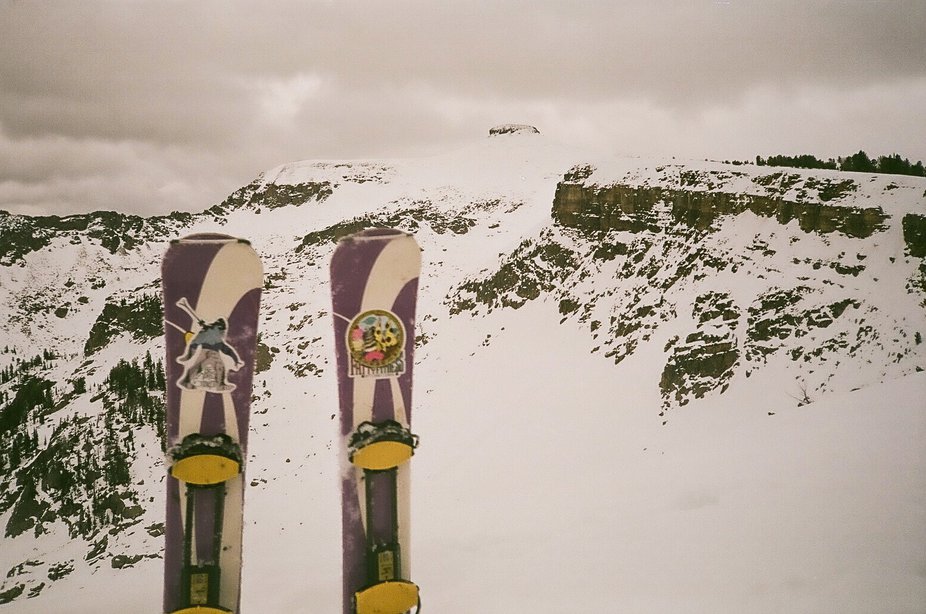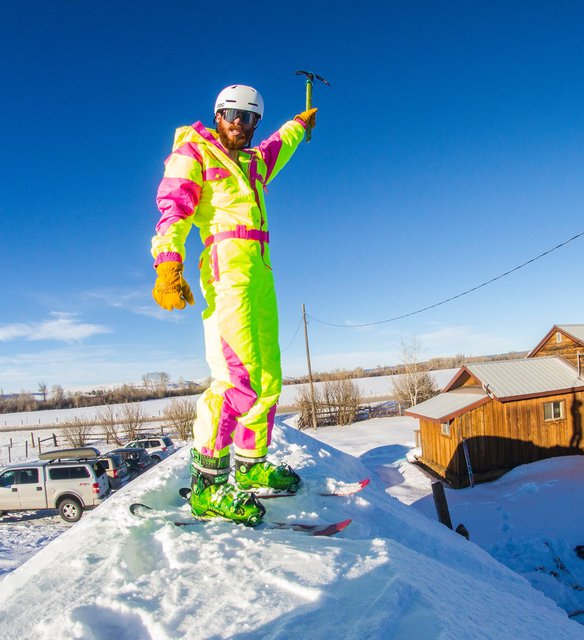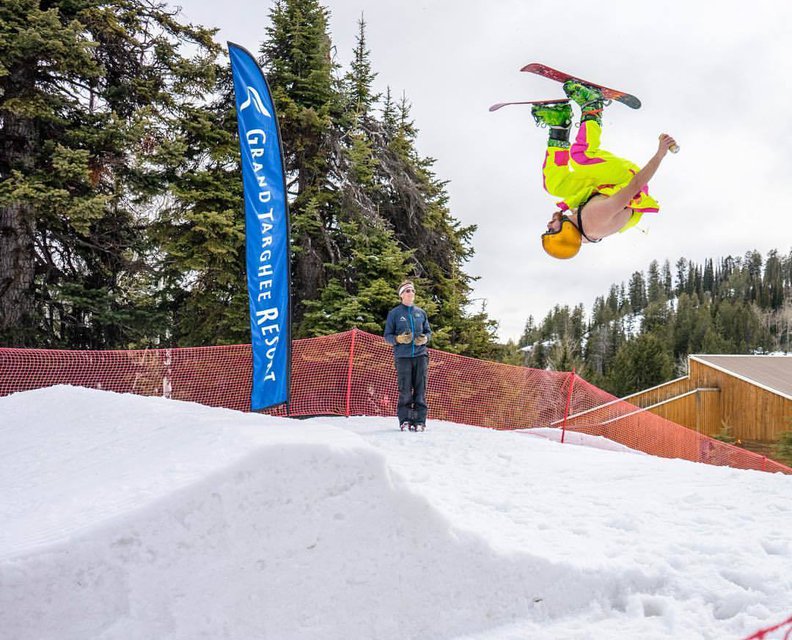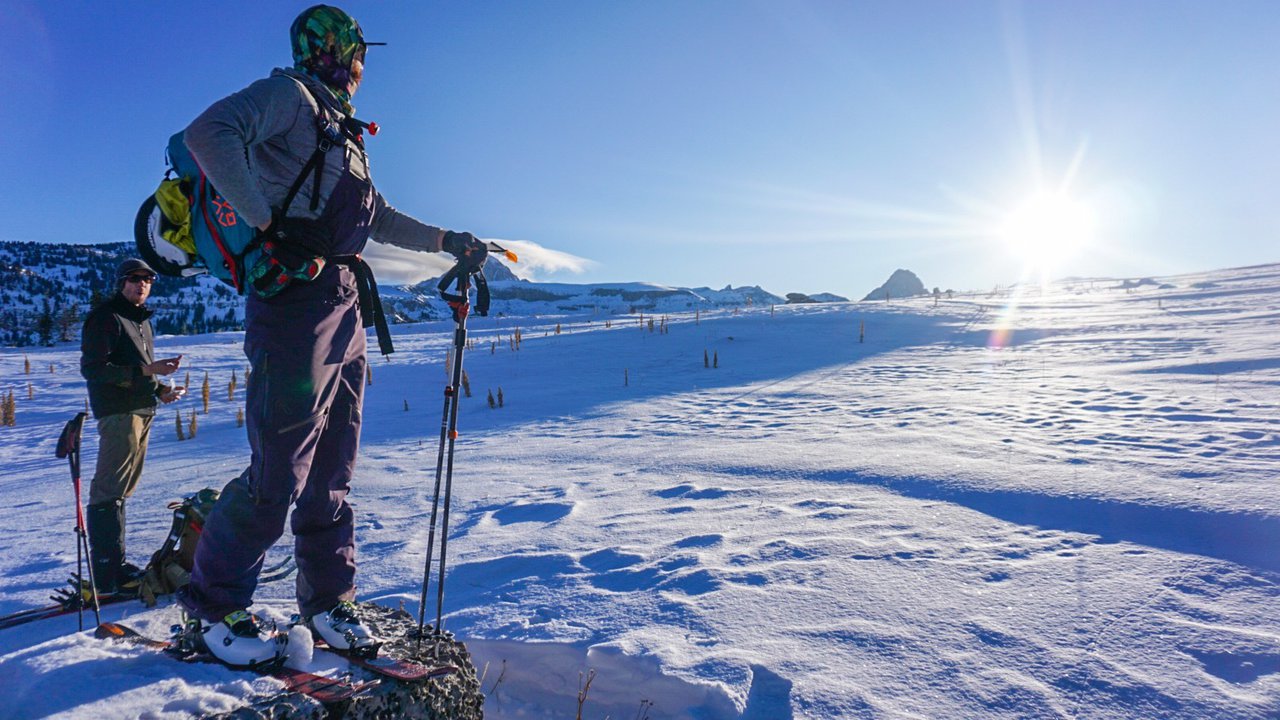Backcountry skiers are obsessed with saving weight. We cut off the handles of our sporks, shave our legs, and drill holes in our gear in the hopes of saving a few grams and being just a little faster up the skin track. I’ve written plenty in the past about how I go about saving weight in my backcountry setup. And plenty of other folks have chimed in with their good, or not so good, ideas.
Now though, looking back at those pieces at the beginning of a new ski season, I realize that we were all wrong. We missed the point. We tried to make small marginal changes in weight distribution, instead of looking for a paradigm shift. I offered a Joe Biden solution to a problem that needed a Liz Warren. Most “weight-saving” strategies save you less weight than taking a big dump before you go skiing would do. We’re milking the last drops out of traditional ski touring gear.
I’ve seen the light. If you really care about the weight of your backcountry setup, you should be touring on ski blades.

My roommate splitboarded this day, I'll leave it to you to decide who was on the worse gear.
Context
In the past, I’ve toured on ski blades a few times. I owned a pair mounted with Silvretta frame bindings. But I stuck to skinning the resort before it opened, or skiing short patches of glacial summer snow. Last fall, I took a pair of ski blades on my first big tour, and my life was changed forever.
We were dealing with very thin snow in the Tetons. Dry trails on the valley floor transition to maybe a foot and a half of snow 3500 feet higher. And that coverage is very aspect dependent. So when we decided to go for a ski traverse from Teton Canyon (on the west slope of the Tetons) to Death Canyon (on the eastern slope, in GTNP) I didn’t feel like taking my favorite touring skis on a walk and putting a bunch of core shots in them.
My partners didn’t feel like beating up their usual touring gear either, so I was joined by a gentleman in mountaineering boots on backcountry nordic skis with the aforementioned Silvrettas, and a lady who only owns one touring setup, and was forced to bring skis to a ski blade fight.
After 18 miles, and 3200 feet of mixed bootpacking, skinning, hiking, and one spicy couloir, I’m sold. Backcountry blades are the future, and somebody needs to put just a little bit of energy into designing, building and selling them.
Why Shift the Paradigm?
I see four main reasons to stop trying to find the lightest skis possible and instead switch to blades: Weight, Length, Safety, and Skiability.
Weight
It’s fun to argue about ski weights (unless the person you’re arguing with is a barbarian who only knows weights in pounds), but even the lightest, dorkiest carbon touring skis bottom out at around 1100 grams per ski. And that’s in a 170 cm length.
My current ski blades are original Line Mike Nick Pros. They are 98 cm long and 100 mm underfoot. They weigh about 850 grams each, and that’s with Line’s “4x4” inserts, which add a little unnecessary weight. They were ostensibly made to compete in freestyle competitions in the X Games, not walk up mountains. But again, 850 grams each.
That means I’m saving about 250 grams per foot by switching from the lightest, most expensive touring skis around to cheap, run-of-the-mill ski blades. For a more relevant comparison: the lightest ski I’ve ever really considered using consistently is the Salomon MTN Explore 95 in the 184 cm length. It weighs about 1550 grams a ski.
By switching to ski blades I saved a whopping 700 grams. What else weighs 700 grams? Two cans of soup, two and a half human hearts, or an average house kitten. Imagine any one of those things strapped to each of your feet on a tour. Would you want to shave that weight? By switching to ski blades from the MTN Explore I’m saving the same total amount of weight as an adult human brain, or just under the weight of a third MTN Explore. I could wear my ski blades, and carry an extra ski and be carrying the same load. And we drill holes in the handles of our sporks instead.

And that’s just the ski’s weight. My skins also weigh half of what my regular skins do. And they pack up twice as small.
Stop shaving your legs, spending thousands of dollars on carbon gear, and carrying less water to save weight. The weight on your feet is being lifted and pushed with every step you take. Cut those grams at the source.
Length
“Long skis truck, short skis suck.” I’ve seen and heard that quote all over the place. In fact, for a while, I believed it and didn’t own anything shorter than a 190 cm ski. But then I remembered that this sort of obsession with length is often symptomatic of deeper problems that can lead to driving stupid huge trucks and rolling coal, so I branched out. I tried shorter skis, and learned that with a good shape, flex, and rocker profile, I’m happiest on about a 184 cm ski. Does it make me uncomfortable that my significant other can also ski 184’s just fine? Nope, she wears my sweatshirts too, and they’re way cuter on her.
A couple of reviewers touched on this in the original piece. They talk about going a few cm shorter for their touring skis. But, what if you went more than a few cm shorter? What if you cut that length in half and then made them fatter?
Here are the pros and cons of length in touring skis as I see them:
Pros of long skis:
- They look better outside the bar
- They allow you to get away with sloppy skiing style on flatter slopes
Cons of long skis:
- A-frames suck when your tails are always hitting rocks and trees
- There’s a lot more ski to coreshot
- Jump turns are more exciting than they need to be
- Shouldering your skis to scramble a few feet is harder than it needs to be
- They get tangled in kick turns
- Side slipping really narrow stuff is impossible
Unless you’re the kind of shallow person who needs to compensate with their ski length, ski blades make much more sense. They are more agile and nimble on the way up. Kick turns are simple and easy, and if you need to hike for a few steps and it’s not worth putting your skis on your pack, you can simply clip their leashes together and sling them over a shoulder.

This is much harder to do on full-size skis
Finally, initiating those first few turns in the steep section of a couloir sucks. It’s scary and dangerous. And if you’ve got to side slip through a four-foot wide pinch in a no-fall zone, good luck. Ski blades excel in steep terrain. You can sideslip just about anything, it’s very easy to rappel with them on, and they’ve got plenty of edge grip. They initiate turns like the US initiates wars in the Middle East: swiftly, and without remorse. The only place they lose out is on those few big fast turns on the apron after the line. And honestly, in that situation, you’re like 15 seconds behind the guy on light touring skis.
Safety
The folks searching for the lightest backcountry setup are usually the folks skiing the lightest, most dangerous, least consistently releasing bindings, with the toes locked. The logic is they’d rather blow a knee than lose a ski and fall to their death. That makes sense, but why even have to make that choice? Traditionally ski blades are used with non-releasable bindings because their shorter length means it’s really hard to get the kind of leverage your knee needs to explode. I ran my ski blades with the Salomon MTN binding, without brakes, and it’s perfect. It’s light, simple, safe, and bombproof. Lock your toes, fear no snows.
Skiability
I think most ultralight skis ride like a microwaved turd. I know, you use a 1200 g ski inbounds and love it. That’s cool. But my ski blades ride better than any sub-1600 gram ski I’ve ever ridden. And again, they weigh half that.
I have bladed inbounds a lot, in variable conditions, keeping up with friends on traditional equipment, skiing fast and taking chances. I have also skied lightweight touring skis inbounds quite a bit. And if you told me I had to race down any run on either those light touring skis or blades, I’d choose blades every time. It takes about half a day to get used to the centered stance they require. Once you’ve done that, they’re fast and intuitive.
Again, people might think I’m being facetious. In anything less than perfect powder, I would rather be on ski blades than the Salomon MTN Explore 95, or anything of that ilk. Full stop. I sideslip less, swear at the gear less, and make more fun, fast, aggressive turns when I am on ski blades. I think you will too.
Durability
Cheap, light, durable: pick two. It goes for bikes, skis, and just about any other toy you’re spending money on. Except for ski blades.
Ultralight skis have a tendency to break at awkward times. You’re eking every gram of material out of the ski, while also trying to maintain a normal-sized footprint. Of course, durability will be compromised.

Kai still beat me in this comp, because he landed his tricks instead of bouncing off his butt and standing up really quickly like I did.
I don’t know much about the construction of my Line Mike Nick Pro ski blades, but I can guarantee you, weight wasn’t a priority. And they still weigh less than any real ski on the market. And they are incredibly durable. I have cased the biggest jumps in the terrain park on them. I have skied over rocks, bushes, and trees. I have walked through asphalt parking lots. I stuck them all the way into icy snow trying to beat Kai Jones in a best trick comp. I have beaten on them harder than any gear I own. And they keep on ticking with nary a whimper. Can you say that about your $1500 vapor-carbon-unicorn-milk skis?
Contrary to what your ski-mo-bro friend says, reliability is more important than low weight in the backcountry. Why not have both with ski blades?
Why isn’t everyone doing this?
So, if ski blades are so much better, why aren’t there more backcountry bladers out there? I think there are a few reasons. One: The ski industry is notoriously stuck in its ways and resistant to change. We still don’t allow snowboarders at Alta for crying out loud.
And two, ski blading has been relegated to a weird niche. It’s only acceptable in costume when you’re not taking yourself seriously. I’ve been guilty of this. I’ve backcountry bladed in my taco costume and hucked my meat in a neon onesey. It’s fun, and it’s great. But ski blading can be so much more. You can ski blade in performance outerwear, with nice bindings and real boots.
To be clear, I’m not the first person preaching this message. Plenty of other folks have taken ski blades into the backcountry and done great things. But not enough people evangelize for the blade lifestyle.
What can we do to change this? Well, first off, put some touring bindings on some ski blades and go for a walk. Free yourself from the false paradigm. Secondly, push the industry to make more backcountry-ready ski blades.
Line, your Mike Nick Pros are awesome. They are also ancient. Make a “Half Sick Day Because I Bailed at Lunch to Get a Head Start on my Weekend Trip.”
J Skis sells the Bladezzz. And JLev is a pioneer of the sport. But man, his current ski blades suck hard. They feel cheap and fragile, and the ride quality is subpar. When they came out I bought a pair to replace my Mike Nick Pros, rode them once, and sold them. Jay, kick out a 102 cm long, 110 mm wide version of your “Friend” ski, and you’ll have a winner. Until then, you’re the father of this damn sport; stop putting your name on a mediocre product.
Moment makes the Frankenblade. I skied a day on them at a prominent Lake Tahoe resort and came away happy, but not blown away. It’s the best inbounds ski blade on the market. But I’m not just an inbounds blader. I need something wider with a little more tip splay to really use in the backcountry. More of a “Wildcat Blade.”
Finally, there are a few weird ski blade-only companies that sell a variety of options. But almost all of them come with the 4x4 insert pattern, and aren’t rated to be mounted with touring bindings. I need something that I can mount any ski binding to, without worrying about my screws tearing out in the middle of nowhere. Also, every time I go to a ski blade-only company website, the web design looks like it’s going to give my computer an STD.
I want a ski blade with normal ski tip splay, a little bit of rocker, a 110 mm + waist, and a skin-friendly tail. Is that too much to ask for?
No. I don’t think it is. I’ve got some Sego Wizard .5’s on the way. Fully rockered, stiff, swallow-tailed, and nice and wide. I’ve got pin bindings waiting for them, I just need some snowboard poles so I can collapse them and put them in my pack for the way down. As soon as I get them my touring skis will start gathering dust in the corner on big couloir days.
I’ve seen the light. Now I just need my blades to show up.



Comments